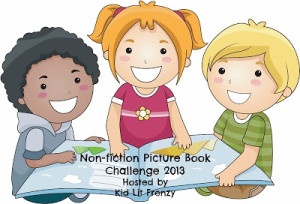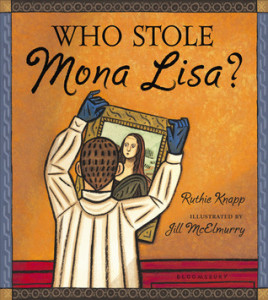Nonfiction Picture Book Wednesday
Nonfiction Picture Book Wednesday is hosted by Kid Lit Frenzy and was started to help promote the reading of nonfiction texts. Most Wednesdays, we will be participating and will review a nonfiction text (though it may not always be a picture book).
Be sure to visit Kid Lit Frenzy and see what other nonfiction books are shared this week!
Who Stole Mona Lisa?
Author: Ruthie Knapp
Illustrated by: Jill McElmurry
Published by September 1st, 2010 by Bloombury USA Childrens
Goodreads Summary: She has a legendary smile, and millions come to see her every day. Some say she is the most famous painting in the world. Who is she? Why, the Mona Lisa, of course! But did you know that she was once stolen from her wall at the Louvre? Who took her? Why? Where was she hidden? How was she found? Someone call the police!
Narrated by the lady of the enigmatic smile herself—and brought to life with gorgeous paintings that take the reader from da Vinci’s renaissance right up to the present day—this is a stylishly whimsical account of the glorious, wonderful, sometimes dangerous life of the best recognized painting of all time. Discover the secrets behind her mysterious smile, and hear for yourself the amazing true story of her kidnapping.
Review: How fascinating! First, let me tell you a little bit about my background. My father has a BA in Art History and an MFA in Museumology. These studies led him to become an executive director of art museums (he is currently directing the Hunter Museum of American Art in Chattanooga, TN) thus impacting my life greatly. My entire childhood has been surrounded by the arts (my mother is a photographer as well). This has made art history something that I am very interested in which then made this book so fascinating for me and I believe it will be incredibly fascinating for all readers.
Mona Lisa is probably the most famous painting of all time, but many, including me, do not know her history. She is more of a mystery that we all are enthralled with than a piece of artwork that is talked about in history class; however, Ruthie Knapp’s book shows us that Mona Lisa’s history is a lot more interesting than we probably thought. And what I think makes this book one that will draw in all sorts of readers is the way she tells the story. The story is told from Mona Lisa’s point of view which makes it more of a caper, mystery type story instead of just informational nonfiction.
Teacher’s Tools For Navigation: As soon as I read this book, I saw how I could use it in the classroom. Seeing things from different points of view and perspectives is something that, as a teacher, I am always trying to help my students achieve. This book, since it is told from Mona Lisa’s point of view, is a perfect example of seeing a situation from a different point of view. After reading Who Stole Mona Lisa? I would start a discussion on how others in the story might have viewed the situation. How would the director of the Louvre have told the story differently? How about Vincenzo Perugia? Parisians? All of these people would have viewed the loss of Mona Lisa differently. These thoughts then could be transferred to anything. Maybe have students choose a historical event and think about it from a different person’s point of view: Babe Ruth’s huge “called” home run from the pitchers point of view, atomic bombings of Japan from a Japanese citizen’s point of view, an event in a book from a different character’s point of view, etc. The options are infinite.
Discussion Questions: How would the director of the Louvre have told the story differently? How about Vincenzo Perugia? Parisians?; Look up other stolen pieces of art. What happened to them?
We Flagged: “Leonardo da Vinci is the artist who painted me. It took him four years! Leonardo loved me. He looked at me while he ate past. He would not travel without me. He said I was his masterpiece. I was famous because Leonardo was famous. Fans jammed his studio to watch him paint.” (p. 10-11)
“The man with the mustache loved me too. He said I reminded him of someone special. He looked at me at every meal: over apples, eggs, and trout; cake and prunes and piglet snout. He looked at me on rainy days, on snowy days, and during summer squalls. He looked at me when he bathed. He looked at me when he shaved. He looked at me for TWO years. I was tired of the man with the mustache. I missed my wall. I missed people staring. I missed children looking sideways and upside down. (p. 24-25)
Read This If You Loved: Nonfiction books about Leonardo da Vinci or Mona Lisa, any books told from inanimate objects’ points of view, Seen Art? by Jon Sciezska, Capture the Flag by Kate Messner, Linnea in Monet’s Garden by Christina Bjork
Recommended For:





